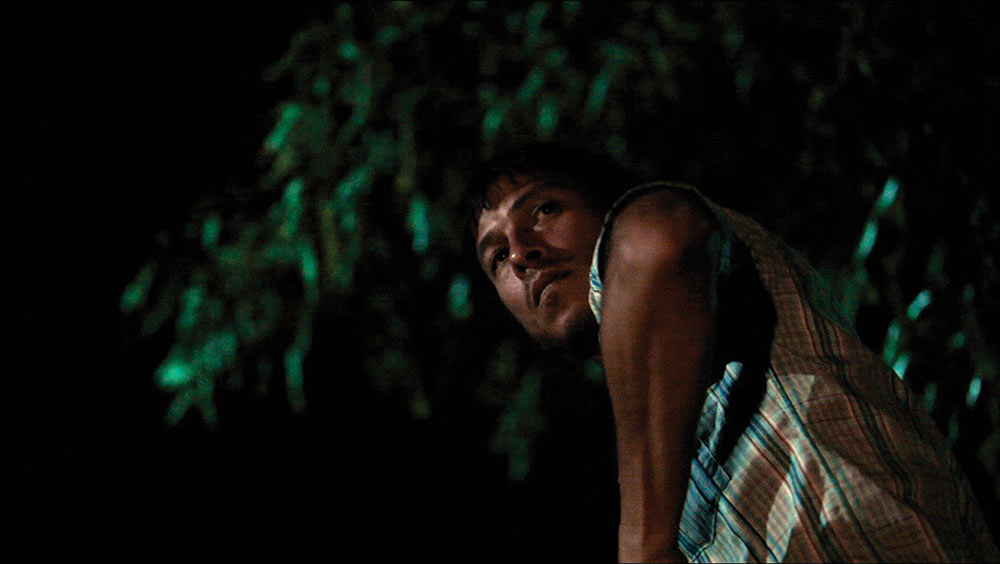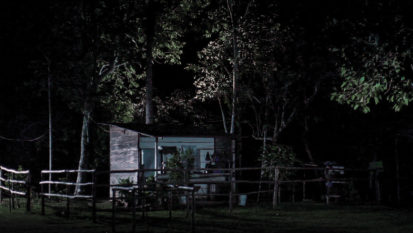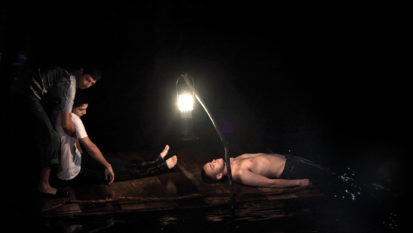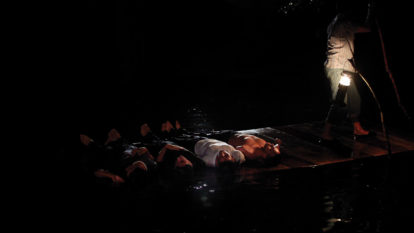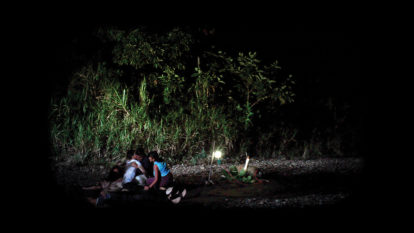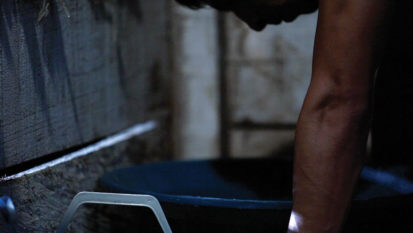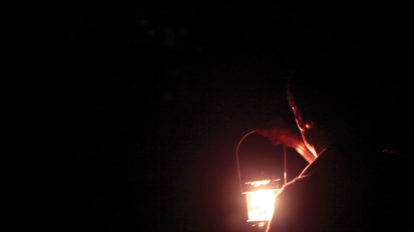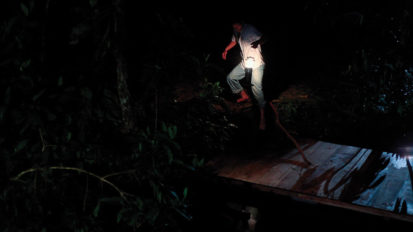Liz Park
I proposed that we talk about your work The Night of the Moon Has Many Hours through a discussion of Gabriel García Márquez’s 1968 novel In Evil Hour. Not only is the story set in Colombia — the country of your origin and the source of inspiration for much of your work — but the vivid description of the riverside town where the events unfold made me think of the setting of your film. To provide a brief overview of the plot, a town mayor desperately seeks to establish political legitimacy, but his efforts are undermined from the very beginning due to his past involvement in election-related violence.
A prominent part of both García Márquez’s narrative and yours, the river functions at both symbolic and practical levels as a conduit for transporting people and goods, and connecting one place to another. Disturbingly, however, we are also introduced to the perilous nature of rivers as well as to their role as a bountiful source of life. In the novel, the ceaseless rain makes the river swell and flood, and in its more menacing form, it threatens the poorest of the residents who live by the riverbank. The river is like a character that evolves throughout the novel. In light of this observation, I am interested in hearing how you would describe the river in your work. I sense the calm of the water in the dark of the night, but the fact that dead bodies are endlessly fished out of it makes it terrifying too.
Mauricio Arango
Before discussing the river in The Night of the Moon Has Many Hours I think it is good to mention some background about the film. As with some of my other projects, the film takes place in the countryside. I like this better than an urban setting because I think that in such a place it is possible to see both men and women in a more naked way, away from all the comforts and indulgences of life in a metropolis. It is not that I see country life in a romantic way. In fact, I see it as the opposite; life in the country can be very harsh (I’m speaking specifically of rural regions in Colombia). The lack of every basic thing you take for granted in a city becomes a major hurdle there. In many Colombian rural regions people live and make do with very little. Even the landscape — nature — becomes a force against them. As such, for my purposes, this rural setting is a stage where human characters play against one another and against the forces that are beyond their control, as in a Greek drama.
In the film, the river is one of the main natural characters, the others being the darkness of the night and the night creatures that we hear but cannot see. I didn’t intend to give a specific meaning to the river and its dark water. But I did want to build in a parallel between the main character’s wandering through the fields and his wading in the water. In both instances he seems determined to get somewhere and to do something. But also, he’s very cautious and alone in a sea of darkness (both literally and figuratively). The river then is like an extension of the night. It is a place to hide things (bodies) with the assurance that the water will keep them out of sight.
I like what you said about rivers being considered a source of life. That’s one thing that attracts me about rural settings, where nature gives and takes in equal measures. A river can dry up or flood, erasing its banks all in an instant, forcing us to start all over again.
LP
We get a sense of the isolation, lack, and harshness of the countryside in Colombia that you speak about in many of García Márquez’s writings too. In Evil Hour sets up the town as a character itself similar to the way you describe the river. In fact, what drives the narrative is the constant barrage of lampoons that get posted in the middle of the night — the whole town is afraid of these lampoons that state an open secret, a town scandal. Throughout the novel, attempts are made to catch the person posting these lampoons, but in the end, we are left with the sense that somehow it is the collective psyche of the town that is both the victim and the perpetrator of this invisible crime. There’s a shared responsibility for what is going on.
This is an important concept that I think is shared in your film; the protagonist and those who come to claim the bodies pulled out of the river recognize the importance of collectively honoring and caring for the dead. In a country that has seen so much violence, I imagine the concept of collective care for the anonymously killed and the unnamed dead is extremely complicated. Would you be able to speak a bit to the political conditions that make it difficult to give proper burial to so many unidentified bodies in the light of day? It is interesting that you say the darkness is a character in your film, because it is also portrayed as a positive aegis under which reclamation of bodies can happen. In contrast, the titular “evil hour” in García Márquez’s novel is the darkness of the night. I recognize that García Márquez was writing from an earlier moment in Colombia’s history under a different set of political circumstances, but do you think the constant between your work and his is this idea of collectivity under duress, so that a group of people can mourn together?
MA
García Márquez’s book alludes to the violence that took place in the first half of the twentieth century in Colombia. I, on the other hand, am interested in the events that took place in the late twentieth century and the early 2000s. If the earlier violence had the two main political parties of the country as its protagonists — their vicious and chronic fighting brought waves of destruction and annihilation — the more recent violence saw development of new events and protagonists.
In the 1960s, the two parties in contention figured out a way to share power and alternately control the country. Although this truce brought some temporary peace, it also left many people in rural communities and in urban intellectual circles feeling disenfranchised and left out of any proper political representation and participation. This precipitated the birth of rural and urban guerrillas, which, over the years, transformed into vast armies, partly fueled by the never-ending supply of money from the drug trade. And things got even more complicated because as a reaction to the growing presence of the guerrillas, large landowners, sectors of the business class, and even members of the political establishment, the army, and the police supported the creation and funding of illegal paramilitary groups. Over time these groups became a fearsome force, challenging the guerrillas on military grounds all over the country. To top it all, the country underwent the devastating effects — endless violence and corruption — of the illegal drugs trafficking. For the sake of brevity I am simplifying things a lot. Nevertheless, as you can see, Colombia’s history is very complex, and Colombians have had a lot to deal with.
A constant throughout all of Colombia’s wars, which I believe is also a constant in any other wars fought elsewhere, is that the brunt of the carnage and the weight of the consequences are always felt the most by the populations caught in the middle.
In my film I tried to evade historical justifications and contextual background for the actions taking place on screen. Instead I relied on the actors performing the sequence of actions that lead to the discovery and delivery of the bodies to allegorize what it is like to be caught alone in a situation like the one portrayed in Colombia. I believe that even in the direst of the situations there are persons who try to make things more bearable and who, through their actions, prevent us from falling into total abjection. One can feel defenseless against the more powerful, but I also think there is a part of our spirit that does not ever fully give up. There’s a part that resists and figures out ways to outsmart the circumstances.
When I was working on this film I came across an article telling the story of a gravedigger who would see bodies floating down the stream. They were coming from a town nearby suffering from the arrival of a paramilitary group; the paramilitary would arrive to a region as conquerors, eliminating anyone whom they consider problematic and making an example of them. This gravedigger couldn’t stand the sight of those dead bodies floating in the water. So, at night, he would fish them out and give them proper burial. He used the cover of the night so that he wouldn’t be seen by anyone and thus avoid upsetting the paramilitaries and getting in trouble himself. Otherwise they would think that he had sided with their enemies. Something as basic as burying a dead body would make you a target. The paramilitaries would rather have rivers infested with the dead. That’s the maniacal logic of a war.
Now, as for your last question, I am not sure I would draw that connection between my work and García Márquez’s book — that there is a collectivity under duress, so that a group of people can mourn together. I say so because in In Evil Hour the collectivity seems to be its very own enemy. The clandestine lampoons that cause so much uproar and tragedy appear to be the work of the whole community. Some of the criticism that I read on this book is about that storyline, the lampoons, being abandoned in the second half of the book. But I think that something García Márquez was getting at is that the town’s people were also the culprit and had a lot to do with making their own fate. In my work I shy away from speaking for or about a collectivity. I think the dynamics inside any group of peoples are very complicated and one always runs the risk of being too broad. I prefer to focus on single actions by individuals or smaller groups of persons, hoping to hint at something larger, a semblance of something I often don’t fully comprehend.
